Description
PRIMARY EFFLUENT TREATMENT: Efficient and Reliable Wastewater Pre-Treatment
Primary effluent treatment is the crucial first step in any wastewater treatment process. This foundational stage removes the largest and most readily separable solids from raw sewage, significantly reducing the load on subsequent treatment stages and enhancing overall system efficiency. Our comprehensive primary effluent treatment solutions offer a robust and reliable approach to this essential process.
What it is:
Primary effluent treatment involves the physical separation of solids from wastewater through processes like screening, grit removal, and sedimentation. This results in a partially treated effluent with a reduced concentration of suspended solids and organic matter. It's a crucial pre-treatment step that lays the groundwork for more advanced secondary and tertiary treatment, if needed.
Key Components & Processes:
Our systems typically incorporate the following components, customized to meet specific site requirements and flow rates:
- Screening: Removes large debris like rags, plastics, and other solid objects that could damage downstream equipment. We offer various screening technologies, including bar screens, fine screens, and comminutors, ensuring optimal removal and minimizing maintenance.
- Grit Removal: Removes inorganic materials like sand, gravel, and grit that can accumulate in subsequent treatment units. Our grit removal systems utilize efficient aerated grit chambers or other proven technologies to effectively separate and remove grit, preventing abrasion and clogging.
- Sedimentation: The core process of primary treatment. Wastewater flows slowly through sedimentation tanks (clarifiers), allowing suspended solids to settle to the bottom, forming sludge. Our clarifiers utilize advanced designs for optimal settling efficiency and sludge removal, minimizing residual solids in the effluent. We offer both circular and rectangular clarifier options.
Benefits of Primary Effluent Treatment:
- Reduced Organic Load: Significantly lowers the organic matter entering secondary treatment, increasing the efficiency and reducing the size of subsequent treatment units.
- Improved Secondary Treatment Efficiency: Prevents clogging and improves the performance of downstream processes such as activated sludge or lagoons.
- Reduced Sludge Volume (in secondary treatment): By removing a large portion of settleable solids upfront, less sludge is produced in subsequent treatment stages. This translates to cost savings in sludge handling and disposal.
- Enhanced Effluent Quality: Results in a clearer effluent with a lower concentration of suspended solids, improving the overall quality of the treated water before it is discharged or further treated.
- Protection of Downstream Equipment: Prevents damage to pumps, pipes, and other equipment by removing large debris and abrasive materials.
- Compliance with Regulations: Helps meet discharge permit requirements and environmental regulations concerning suspended solids.
Customization and Scalability:
Our primary effluent treatment systems are designed for scalability and flexibility, accommodating a wide range of flow rates and site-specific conditions. We provide comprehensive design, engineering, construction, and commissioning services, ensuring seamless integration into your existing or new wastewater treatment plant. Our solutions are tailored to meet your specific needs, budget, and regulatory requirements.
Contact us today to discuss your specific wastewater treatment needs and explore how our primary effluent treatment solutions can optimize your process and improve your overall efficiency.
